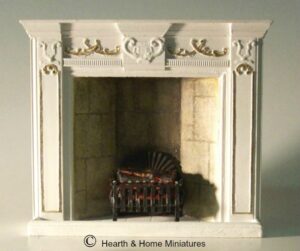The weather is getting colder, and what better time to light the fire.
But which fire? Dolls House Direct sell over 150 different fire places to suit all kinds of themes and budgets. Thanks to brands like Artisan Designs, Sussex Crafts, Hearth and Home Miniatures and Glow Well Designs, our collection of fireplaces just keeps growing!
We’d love to write about them all, we just haven’t got the time! Instead, we’ve hand-picked some of our most popular to explore in more detail.
A Brief History
The fireplace was a necessity in early Britain. As the hub of the house, a burning hearth provided heat, housed multiple fires for cooking and baking, and served as the nucleus of family gatherings. In the 1600s and early 1700s, the typical fireplace was a walk-in: a wide, deep, open recess, generally with only the briefest semblance of a mantel, or no mantel at all. The firebox was usually wider than it was tall, especially across the North Sea in the Netherlands.
Fireplaces in English homes were smaller and more efficient. In New England and the Mid-Atlantic, colonial homes had central chimneys with multiple flues so that fires could be lit in two or more rooms on each floor. The central mass of stone or brick also tended to retain heat, keeping the house warmer overall. In the South, fireplaces were placed at the far ends of the house to reduce heat build-up, keeping the house cooler in summer.
True mantels were rare before the 1800s. The very earliest American hearths were flush with the wall. In English colonial homes, fireplaces typically were surrounded by simple, floor-to-ceiling paneling, usually plain vertical or bead-edged planks. If the house was Dutch, the fireplace flue projected into the room, concealed by a massive hood. Decorative enhancements might include a few Delftware tiles, or in the case of the Dutch, a short decorative curtain that hung well above the fire pit.
By the second quarter of the 18th century, the fireplace had become the centrepiece of the main gathering room. Decorative paneling and other accents in the Georgian style were book-matched on either side of the opening, sometimes for the entire width of the wall.
While fireplaces large enough to stable a cow continued to be popular well into the early 19th century, around 1795 Sir Benjamin Thompson began fiddling with the design of the firebox. The result of his efforts is the basis for all open fireplaces today. Taller than it is wide and smaller and shallower than older styles, the Rumford fireplace has sharply angled covings on either side. The ingenious design throws more radiant heat into a room than its predecessors. Another key element is its narrow throat, which exhausts both smoke and air at an increased speed, acting as a check against backdrafts.
By the mid-1800s, as the country industrialized and became more urban, households were burning coal rather than wood. Grates were smaller and held lumps of coal in iron baskets. Surrounds got a makeover, too: The new style was cast iron in a horseshoe-arch shape, embellished by the many decorative flourishes of the Rococo Revival style, which were easily captured by the casting process.
As the Victorian age progressed, fireplaces became more ornate, with overmantels and columns. Options included complete cast-iron combination fireplaces (the first inserts!) and fireplaces with decorative tiles running along the legs of the surround. Later, surrounds were trimmed with glazed lozenge-shaped tile in a host of colours.
There would soon be a backlash, of course: In the early 20th century, fireplaces and mantels became much simpler, with those in Colonial Revival houses harking back to the motifs popularized in the late 1700s and early 1800s, sometimes liberally mixing and matching elements like 1750s Georgian moldings with 1840s Greek Revival fluting. Surrounds were simply finished with brick or stone like the fireplace above.
The back-to-nature movement had an effect, too: Many homes were treated to full-on fireplaces built of river rock or stone. This rustic style spilled over into the burgeoning Arts & Crafts movement, where materials from clinker brick to the more refined dressed stone and scenic art tile graced “modern” fireplaces.
Fireplace Accessories
With your fireplace lit, it’s time to think about accessorising! Whether it’s frying pans, cauldrons, companion sets, cranes, mantles or hearths, you can be sure you’ll find what you need at SussexCrafts. Our extensive range of cast iron miniatures don’t just look the part, they’re fully functional too.

Whether highly ornate or simple and rustic, a fireplace continues to be a source of warmth and comfort in the home—still one of the most desired elements in any period dolls house today.
We hope you enjoyed this blog and found it useful. Please get in touch if you have any questions about any of our fireplaces.






